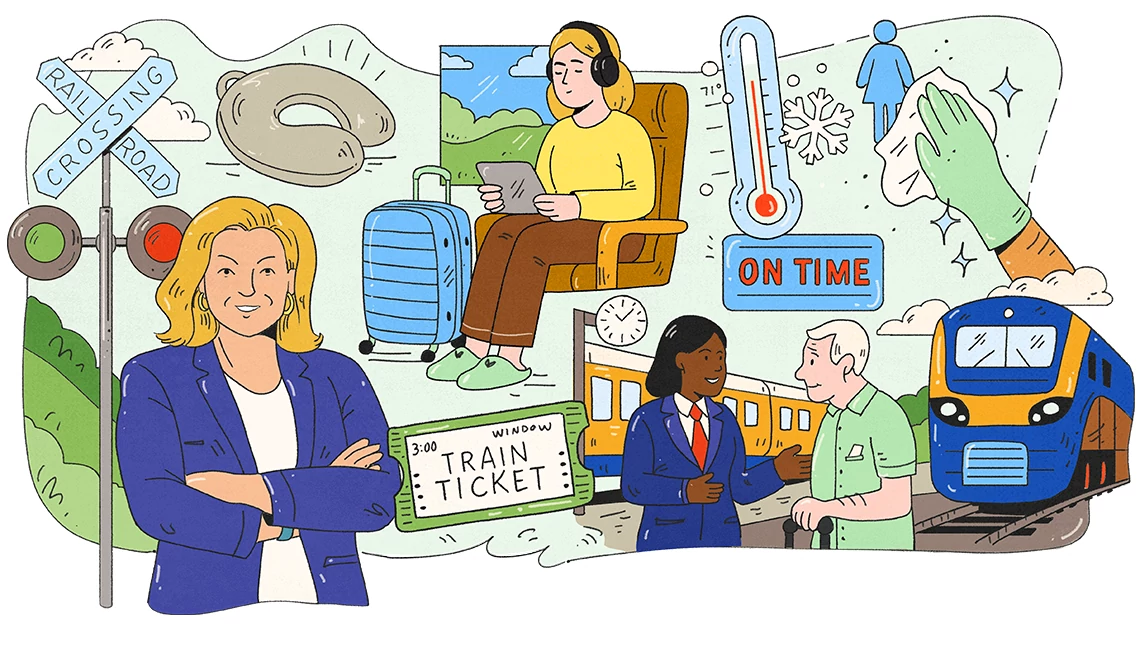AARP Hearing Center
Background
In the second quarter of 2024, Americans owed $1.6 trillion in outstanding student loan debt. Although younger people hold most of this debt, older Americans increasingly find themselves saddled with student loan debt as well. Approximately 25 percent of this debt, or $391 billion, is held by people age 50 and older.
Impact on retirement savings: Carrying student debt throughout one’s working years makes it harder for people to save for retirement. Moreover, student debt can directly affect retirement income, as those who default on federal student loans are subject to Social Security offset (similar to garnishment). Up to 15 percent of their monthly Social Security checks can be offset to repay federal student loans.
Older Americans who obtain student loans to help finance the cost of college for others primarily use two types of loans.
- Parent PLUS loans: These are offered directly to parents of undergraduates from the federal government with limited underwriting. As such, Parent PLUS borrowers sometimes lack the ability to repay the loan. Moreover, there are no official income-driven repayment plans for Parent PLUS borrowers.
- Cosigned private student loans: Financial institutions usually will not make a loan directly to a student alone. Instead, they require a cosigner. Often, parents, grandparents, and other family members serve as cosigners. Many cosigners do not understand that they are legally responsible for repaying a loan if the student fails to do so.
Role of the high cost of higher education: The cost of attendance at colleges and universities has risen much faster than inflation and wage growth. This is one factor that has led to the high level of debt among older adults. Today, the amount of federal student loans and grants available to students covers a much lower proportion of the overall cost of college attendance. Students increasingly must rely on parents, grandparents, and others to help fund their education.
In order to expand the opportunity to attend college to people with low and moderate incomes, some states are offering new tuition-assistance programs that lower the cost of attendance. At least 32 states offer tuition-free college programs. Many offer this after considering scholarships, Pell, and other grants.
Student loan impact by race and ethnicity: Student loans pose disproportionate burdens on people from nonwhite racial and ethnic groups. They take out more student loans. For example, 81 percent of African American and 60 percent of Hispanic/Latino undergraduates take out student loans, compared with 59 percent of white undergraduates. In addition, Black and Hispanic/Latino borrowers are more likely to default on those loans. The widening wealth gap between white and nonwhite people can help explain both this higher propensity to take out loans and the higher rates of loan default.
Problems with for-profit colleges: For-profit colleges claim to expand educational opportunities for underserved populations, who are more likely to attend them. This includes racial and ethnic groups that are discriminated against, people with low incomes, single parents, and older students seeking new skills. But for-profit colleges are expensive and often do not offer valuable educational opportunities for students. This makes them especially risky for the vulnerable students who typically enroll. More than half of them ultimately drop out. One study found that the vast majority of for-profit college students experience higher debt and lower pay than they did before.
Given the high cost and negative outcomes of for-profit colleges, these institutions sometimes use aggressive sales tactics, such as highlighting false program graduation and employment rates, to attract students. Over the past several years, the federal government provided $28.7 billion in loan forgiveness to more than 1.6 billion borrowers who were cheated by their schools, saw their schools close, or were covered by court settlements.
Income-share agreements (ISAs): In recent years, some colleges and noncollege training programs have started offering ISAs as an alternative or complement to traditional student loans. ISAs provide students with up-front educational funding in exchange for a percentage of future income. They may substitute for parent borrowing or private student loans. But ISAs also have the potential to be a more expensive and riskier option than other forms of financing.
Abuses in servicing and debt collection: Regardless of the program's quality, once a borrower is required to repay a student loan, other potential problems can arise. Student loan servicers are companies that collect debt payments on behalf of lenders. Servicers have often been accused of engaging in deceptive practices. A 2024 CFPB report on consumer complaints found that servicers made a range of costly errors that led to consumer hardship. These included miscalculated billing statements, miscredited payments, credit reporting errors, and delays in discharging loans. Sometimes, servicers are not placing borrowers into repayment plans that would substantially lower their monthly payments even though they meet eligibility requirements. Instead, servicers simply suspend payments for struggling borrowers, which increases the interest owed over the life of the loan.
Highlighting problems in the servicing industry, in 2024, the CFPB filed a proposed order against Navient “for years of failures and lawbreaking.” Navient illegally steered borrowers into more costly repayment options by preventing them from enrolling in affordable income-driven repayment plans. The order would ban Navient from continuing to service or acquire federal student loans in the future. It would also require Navient to pay $100 million in redress for harmed borrowers and $20 million in penalties.
In response to servicing challenges, several states have established student loan ombudsmen to monitor and address borrowers’ concerns. Some now also license student loan servicers for both federal and private loans. This enables states to ensure that minimum standards are met and that servicers can be held accountable if they fail to adequately meet borrowers’ needs.
For many years, both federal and private student loans have been largely ineligible to be discharged in bankruptcy, unlike other types of consumer debts. However, federal regulators made this easier in 2022 (see also Bankruptcy). Bankruptcy discharges for student loans historically were only available in very limited circumstances, often requiring the borrower to prove a higher standard of financial distress than what is necessary to discharge other types of debt. Federal loans could be discharged administratively outside of bankruptcy in cases of death, permanent disability, or a small number of other scenarios. In 2022, however, the Justice Department and the Education Department issued guidance to help borrowers seeking hardship discharges. This made it easier to discharge student loan bankruptcy debt. As of this writing, it is unclear whether this guidance will remain in place.
Federal repayment plans: The Department of Education offers income-driven repayment plans for students who take out loans but cannot afford the standard payment amount. Typically, borrowers who make all payments on time have the rest of their debt forgiven at the end of the loan period. However, federal Parent PLUS borrowers cannot directly enroll in these plans. Those wishing to do so must first consolidate their federal loans and then apply for the least generous such plan. This could still leave them in debt for 25 years.
Redress for harms: Students at some institutions—including 98 percent of students at federally funded for-profit colleges—are prohibited from going to court to settle disputes. Instead, they are required to go to arbitration and may not pursue class claims even in arbitration (see also Pre-Dispute Mandatory Binding Arbitration). This is true even though some of these for-profit institutions have engaged in fraud or have not provided a return on the substantial investment a student may have paid. In these situations, students can suffer high financial damages and end up without a degree and with credits that cannot be transferred to other institutions.
STUDENT LOANS: Policy
STUDENT LOANS: Policy
Affordability
Higher education institutions should set tuition and fees to ensure affordability and expand educational opportunities for all. They should establish and expand innovative programs to lower the cost of attendance. Tuition and fees should be transparent.
Investment and oversight
Federal and state policymakers should increase public investment in higher education to facilitate cost containment.
They should provide robust oversight and regulation to:
- ensure transparency, and
- prohibit higher education institutions, loan originators, student loan servicers, and student loan debt collectors from engaging in unfair, deceptive, or abusive practices.
Increased public investment: State policymakers should increase investment in state university systems. This should include increasing per-student tuition subsidies and providing free or reduced-cost tuition for students with low and middle incomes.
Federal policymakers should increase the number of students who receive federal need-based grant aid (such as Pell grants) and the amount each student is eligible to receive.
Federal policymakers should expand federal student loan availability, including subsidized loans, for students themselves to take out to decrease reliance on private student loans and Parent PLUS loans.
Policymakers should put in place other mechanisms to lower the overall cost of attendance and thereby decrease the need to take out increasing amounts of student loan debt.
Robust oversight: Federal and state policymakers should provide oversight to determine whether higher education institutions are making investments that increase educational opportunities for students rather than simply expanding amenities. States should license and oversee student loan servicers and student loan debt collectors operating in their states to protect borrowers from unfair, deceptive, or abusive practices. In particular, oversight is needed to ensure that servicers and debt collectors properly apply payments, correctly advise on repayment options, and accurately report to credit bureaus.
Higher education institutions should provide information on how revenues are spent as well as key outcomes for students and graduates. This includes the percentage of students who graduate, employment rates, and salary data for program graduates.
Protection against unfair, deceptive, or abusive practices: For-profit schools and programs that do not provide a return on investment should not enroll students. In making such a determination, federal and state policymakers should consider factors such as the percentage of students who graduate, level of student loan debt coming out of the program, percentage of attendees who default on their student loan debt, percentage of attendees or graduates who are employed, and average earnings for attendees or graduates.
Federal and state policymakers should put in place policies to align the financial outcomes of for-profit colleges and programs with student success. For example, programs with low graduation rates, low employment rates, low salaries relative to debt incurred, or a combination of these should not be able to receive federal student aid. Students should typically be able to earn enough money after leaving a program to be able to pay back the student debt they took out to attend a program.
Federal and state policymakers should prohibit misleading marketing practices. This includes misrepresenting data related to program outcomes, such as graduation rates or the employment rates and salaries of graduates.
Federal policymakers should continue to require schools to be accredited in order for their students to receive federal financial aid, including federal student loans.
Federal and state policymakers should strengthen accreditation standards to better focus on program quality, including considering whether schools and programs are providing skills that will lead to gainful employment.
Students who took out federal student loans for an educational institution that has been shown to have defrauded students should be eligible for loan forgiveness. To the extent possible, the cost of discharging these loans should be borne by the fraudulent school, not taxpayers.
Student loan servicers should be required to provide cosigners with statements and other loan information as a matter of course. They should also streamline the process to efficiently enroll eligible borrowers in public service loan forgiveness and income-driven repayment plans.
States should also establish an office of the student loan ombudsman to provide timely assistance to student loan borrowers.
Income-share agreements (ISAs)
All financial aid, including grants and federal student loans, should be exhausted before a student is offered an ISA.
Policymakers should put in place robust consumer protections for ISAs. This includes:
- Requiring higher education institutions and programs to evaluate whether a student can reasonably be expected to repay their student loans and any ISA. For example, a maximum limit could be set as a percentage of income, taking into account both repayment obligations.
- Limiting the loan term.
- Prohibiting excessive fees and penalties.
- Ensuring access to redress (see also Private Enforcement of Legal Rights and Pre-Dispute Mandatory Binding Arbitration).
ISA programs should be required to comply with federal and state consumer finance and civil rights laws. This includes fair lending and wage garnishment laws. In addition to providing disclosures of the loan terms required under the Truth in Lending Act, they should provide full, accurate, and understandable disclosures about how the program works and its expected impact on future earnings.
Repayment during declared emergencies
Federal student loan providers should defer payments automatically without penalty or interest during declared emergencies. In addition, Congress should appropriate funds to ensure that these deferments apply to federal student loans that are not held by the government. Private lenders should offer more payment flexibility, including the option of deferral.
Communication of repayment options
People who seek to take out or cosign student loans should receive clear information on their responsibility for repaying the loan. Once they are required to repay a loan, they should be able to choose among affordable repayment options with consumer protections. Those options should include seamless access to income-driven repayment plans for federal loans. Refinancing with consumer protections should also be an option. Federal borrowers in default should be given the ability to enroll in income-driven repayment plans and public service loan forgiveness if qualified.
Financial aid award letters should be uniform (comparable among schools). They should include, in a simple and understandable format, a breakdown of grant aid and loan aid.
Parent PLUS borrowers should be eligible and able to enroll easily in income-driven repayment plans.
All federal borrowers should be able to receive income-driven repayment plans (and, if qualified, public service loan forgiveness) while in default.
Student loan refinances should incorporate consumer protections. These include:
- The annual percentage rate of the new loan should be lower than that of the existing loan, even if the overall loan term is longer.
- Federal borrowers seeking to refinance should be first informed whether they qualify for income-driven repayment plans, public service loan forgiveness, or both. These may provide more relief than a private loan refinance and incorporate other consumer protections.
Bankruptcy treatment of student debt
Federal policymakers should expand the circumstances in which student debt is dischargeable in bankruptcy (see also Bankruptcy). This may include:
- loans that do not provide access to income-based repayment options,
- private loans that lack death or disability discharges, and
- loans taken out for programs with documented histories of engaging in unfair, deceptive, or abusive acts and practices.
Social Security beneficiaries and student debt
Social Security benefits should not be offset to collect federal student loan debt (see also Garnishment of Social Security Benefits).
Benefits provided by the Department of Veterans Affairs and income tax refunds likewise should be protected from garnishment, levies, and offsets.
Arbitration in education contracts
Mandatory binding arbitration and restrictions on participating in class action lawsuits should be prohibited in higher education contracts (see also Pre-Dispute Mandatory Binding Arbitration).































































